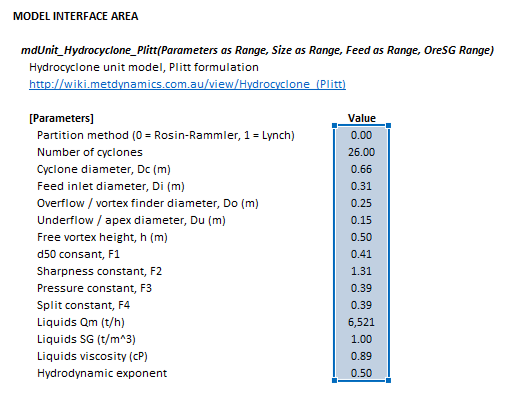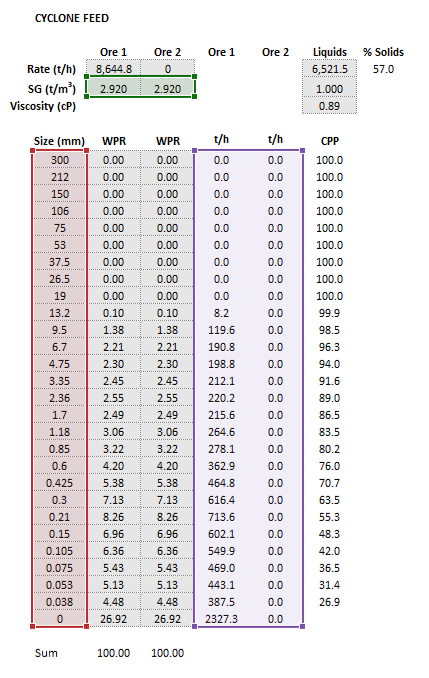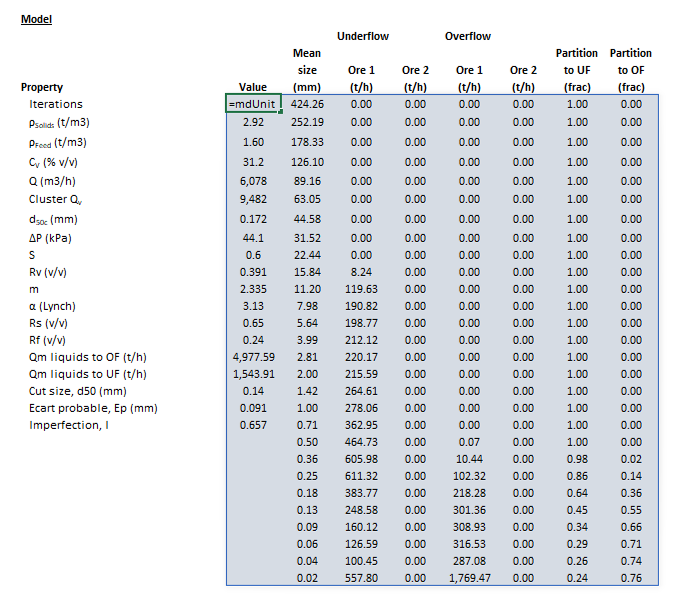Hydrocyclone (Plitt): Difference between revisions
md>Scott.Munro m (→Results) |
Scott Munro (talk | contribs) m (1 revision imported) |
(No difference)
| |
Revision as of 13:24, 2 January 2023
Description
This article describes the Plitt model for hydrocyclone classification, which is based on the original work of Plitt (1976) and updated by Flintoff (1987).[1][2]
Following a review of the Plitt model, Nageswararao et al. (2004) concluded:[3]
Because the model was published in full and thus enterered[sic] the public domain, the Plitt model saw widespread early use, particularly as a teaching tool. Following the addition of the Flintoff corrections, the Plitt model has also seen industrial use. With the proviso ... that, if at all feasible, the model should be fitted to data obtained under conditions as close as possible to those to be simulated, the model can be expected to give useful results.
Model theory
Plitt provides a method of computing the classification of particles by size, incorporating the so-called bypass of fines to the underflow stream.
Plitt's partition by size equation is:
where:
- is the index of the size interval, , is the number of size intervals
- is the uncorrected, i.e. actual, partition to underflow of particles in size interval (frac)
- is the corrected partition to underflow of particles in size interval (frac)(frac), i.e. excluding the fines bypass effect
- is the fraction of feed liquids recovered to underflow (frac)
Plitt suggests applying either the Rosin-Rammler or Lynch exponential sum partition curves to compute the uncorrected classification by size:
where:
- is the geometric mean size of particles in size interval (mm)
- is the size at which 50% of the particle mass reports to underflow and 50% to overflow (mm)
- and are parameters which quantify the sharpness of separation of the Rosin-Rammler and Lynch partition curves, respectively
The corrected cut size, (μm), and partition curve shape parameters, and , are calculated with:[3]
where:
- - are calibration factors which should be fitted from operating data
- is the cyclone feed pressure (kPa)
- is the ratio of underflow to overflow volumetric flow rates (frac)
- is diameter of the cyclone (cm)
- is diameter of a circular inlet or the diameter of a circle with the same area as a non-circular inlet (cm)
- is diameter of the vortex finder (overflow) (cm)
- is diameter of the apex/spigot (underflow) (cm)
- is the free vortex height (cm)
- is the liquid viscosity (cP)
- is the volume fraction of solids in the feed, in percentage units (%)
- is the volumetric feed rate to the cyclone (L/min)
- is density of solids in the feed (t/m3)
- is density of liquids in the feed (t/m3)[4]
- is density of the feed slurry (t/m3)
- is the hydrodynamic exponent (typically between the values of 0.5 for laminar flow and 1.0 for turbulent flow)
The fraction of feed liquids recovered to underflow () is computed from:
where is the volumetric recovery of pulp to the underflow (frac):
The recovery of solids to underflow, (frac), is computed from the fractional distribution of mass by size in the feed, (w/w), and the partition , i.e.:
It can be seen from the above equations that and are interdependent via the partition . Therefore, an iterative procedure is used to calculate and refine the values of and . Few iterations are typically required for solution.
Partition metrics
Several metrics are provided to characterise the partition curve.[4]
The , also known as the cut or separation size, is defined as the size of a particle which has an even (50%) chance of appearing in either the underflow or overflow stream. The size is estimated via a log-linear interpolation of geometric mean size () against the uncorrected partition to underflow of all solids in the feed.
The Ecart Probable, or , is a measure of the deviation of a partition curve from a perfect separation, and is typically defined for size classification as:
where and are the sizes of particles which have a 75% and 25% probability, respectively, of appearing in the underflow stream. The and sizes are estimated by log-linear interpolation of geometric mean size against the uncorrected partition to underflow of all solids in the feed.
The Imperfection, , is a normalised measure of the sharpness of separation, which is suggested to be independent of the magnitude of the , and is typically defined for size classification as:
Roping
Several methods are available to identify the potential for roping discharge from a hydrocyclone underflow.
Plitt proposed that roping may occur when the volumetric feed rate to the cyclone, (m3/h), exceeds a solids capacity limit:[5]
Plitt further proposed a limit to the volume fraction of solids in cyclone underflow, (% v/v), of:
where is the mass median particle size of the underflow, computed here as the P50 (μm).
The SPOC criterion indicates roping may occur when:[6]
where is the percentage volume fraction of solids in the underflow stream (% v/v). The SPOC criterion is only valid when .
Investigations by Bustamante (1991) and Concha et al. (1996) led to the limiting values of cyclone geometry in Table 1:[4]
Table 1. Transition from spray to roping discharge (after Gupta and Yan, 2016).[4] Source Condition Bustamante <0.34 Roping discharge 0.34 - 0.5 Roping or spray >0.5 Spray discharge Concha et al. <0.45 Roping discharge 0.45 - 0.56 Roping or spray >0.56 Spray discharge
Excel
The Plitt hydrocyclone model may be invoked from the Excel formula bar with the following function call:
=mdUnit_Hydrocyclone_Plitt(Parameters as Range, Size as Range, Feed as Range, OreSG as Range)
Invoking the function with no arguments will print Help text associated with the model, including a link to this page.
Inputs
The required inputs are defined below in matrix notation with elements corresponding to cells in Excel row () x column () format:
where:
- is the partition curve function to apply, 0 = Rosin-Rammler, 1 = Lynch
- is the number of cyclones operating in a cluster. Model calculations are scaled per cyclone.
- is the number of ore types
- is feed solids mass flow rate by size and ore type (t/h)
- is the mass flow feed rate of liquids into the cyclone (t/h)
Results
The results are displayed in Excel as an array corresponding to the matrix notation below:
where:
- is the number of iterations required to refine the interdependent values of and
- is the mass flow rate of liquids to the overflow stream (t/h)
- is the mass flow rate of liquids to the underflow stream (t/h)
- is mass flow rate of solids to the underflow stream (t/h)
- is mass flow rate of solids to the overflow stream (t/h)
- is partition fraction of feed solids to the underflow stream (frac)
- is partition fraction of feed solids to the overflow stream (frac)
Example
The images below show the selection of input arrays and output results in the Excel interface.
SysCAD
The sections and variable names used in the SysCAD interface are described in detail in the following tables.
ScdMD*Hydrocyclone page
The first tab page in the access window will have this name.
| Tag (Long/Short) | Input / Display | Description/Calculated Variables/Options |
|---|---|---|
| Tag | Display | This name tag may be modified with the change tag option. |
| Condition | Display | OK if no errors/warnings, otherwise lists errors/warnings. |
| ConditionCount | Display | The current number of errors/warnings. If condition is OK, returns 0. |
| GeneralDescription / GenDesc | Display | This is an automatically generated description for the unit. If the user has entered text in the 'EqpDesc' field on the Info tab (see below), this will be displayed here.
If this field is blank, then SysCAD will display the unit class ID. |
| Requirements | ||
| On | CheckBox | This enables the unit. If this box is not checked, then the feed material will pass directly to the overflow stream. |
| Method | User defined | The partition to underflow for each size interval is defined by the user. Different values can be used for different solids. |
| Whiten-Beta | The partition to underflow for each size interval is defined by a Whiten-Beta efficiency curve. Different parameters can be used for different solids. | |
| Nageswararao | The Nageswararao model is used to determine the partition of solids to underflow and overflow for each size interval. | |
| Narasimha-Mainza (2014) | The Narasimha-Mainza (2014) model is used to determine the partition of solids to underflow and overflow for each size interval. | |
| Narasimha-Mainza (Multi) | The Narasimha-Mainza (Multi) model is used to determine the partition of solids to underflow and overflow for each size interval. | |
| Plitt | The Plitt model is used to determine the partition of solids to underflow and overflow for each size interval. | |
| Options | ||
| ShowQFeed | CheckBox | QFeed and associated tab pages (eg Sp) will become visible, showing the properties of the combined feed stream. |
| ShowQOF | CheckBox | QOF and associated tab pages (eg Sp) will become visible, showing the properties of the overflow stream. |
| ShowQUF | CheckBox | QUF and associated tab pages (eg Sp) will become visible, showing the properties of the underflow stream. |
| RopingCalcs | CheckBox | Show addition calculations that predict the onset of cyclone underflow roping. |
| SizeForPassingFracCalc | Input (global) | Size fraction for % Passing calculation. The size fraction input here will be shown in the Stream Summary section. |
| FracForPassingSizeCalc | Input (global) | Fraction passing for Size calculation. The fraction input here will be shown in the Stream Summary section. |
| Stream Summary | ||
| MassFlow / Qm | Display | The total mass flow in each stream. |
| SolidMassFlow / SQm | Display | The Solids mass flow in each stream. |
| LiquidMassFlow / LQm | Display | The Liquid mass flow in each stream. |
| VolFlow / Qv | Display | The total Volume flow in each stream. |
| Temperature / T | Display | The Temperature of each stream. |
| Density / Rho | Display | The Density of each stream. |
| SolidFrac / Sf | Display | The Solid Fraction in each stream. |
| LiquidFrac / Lf | Display | The Liquid Fraction in each stream. |
| Passing | Display | The mass fraction passing the user-specified size (in the field SizeForPassingFracCalc) in each stream. |
| Passes | Display | The user-specified (in the field FracForPassesSizeCalc) fraction of material in each stream will pass this size fraction. |
Cyclone page
The Cyclone page is used to specify the input parameters for the hydrocyclone model.
{{{ActionU}}} page
The {{{ActionU}}} page is used to display (or specify) the {{{ActionL}}} by species/component/element/individual phase and size values.
| Tag (Long/Short) | Input / Display | Description/Calculated Variables/Options |
|---|---|---|
| Distribution | ||
| Name | Display | Shows the name of the SysCAD Size Distribution (PSD) quality associated with the feed stream. |
| IntervalCount | Display | Shows the number of size intervals in the SysCAD Size Distribution (PSD) quality associated with the feed stream. |
| SpWithPSDCount | Display | Shows the number of species in the feed stream assigned with the SysCAD Size Distribution (PSD) quality. |
| {{{ActionU}}} | ||
| Method | Model / User | Select model-calculated or user-defined {{{ActionL}}} to separate each solids species type. |
| Density | Display | Density of each solid species. |
| Size | Display | Size of each interval in mesh series. |
| MeanSize | Display | Geometric mean size of each interval in mesh series.
|
| All (All column) | Display |
|
| {{{ActionU}}} | Display |
|
| All (All row, All column) | Display |
|
| All (All row, per species) | Display |
|
| Cmp{{{ActionU}}} | ||
| Components | Hides or shows component {{{ActionL}}} table. | |
| Size | Display | Size of each interval in mesh series. |
| MeanSize | Display | Geometric mean size of each interval in mesh series. |
| All (All column) | Display |
|
| Cmp{{{ActionU}}} | Display |
|
| All (All row, All column) | Display |
|
| All (All row, per component) | Display |
|
| Ele{{{ActionU}}} | ||
| Elements | Hides or shows element {{{ActionL}}} table. | |
| Size | Display | Size of each interval in mesh series. |
| MeanSize | Display | Geometric mean size of each interval in mesh series. |
| All (All column) | Display |
|
| Ele{{{ActionU}}} | Display |
|
| All (All row, All column) | Display |
|
| All (All row, per element) | Display |
|
| IPh{{{ActionU}}} | ||
| IPhases | Hides or shows individual phases {{{ActionL}}} table. | |
| Size | Display | Size of each interval in mesh series. |
| MeanSize | Display | Geometric mean size of each interval in mesh series. |
| All (All column) | Display |
|
| IPh{{{ActionU}}} | Display |
|
| All (All row, All column) | Display |
|
| All (All row, per individual phase) | Display |
|
Roping page
This page displays the results for hydrocyclone roping limit calculations. The page is only visible if Roping is selected on the MD_Hydrocyclone page.
| Tag (Long/Short) | Input / Display | Description/Calculated Variables/Options |
|---|---|---|
| Roping | ||
| Underflow | ||
| SolidsVolFlow / SQv | Display | Volumetric flow rate of solids in cyclone underflow stream. |
| Plitt.MSu | Display | Plitt's volumetric flow rate of solids in cyclone underflow roping limit. |
| SolidsVolFrac / Svf | Display | Volume fraction of solids in the cyclone underflow stream. |
| SPOC | Display | SPOC volume fraction of solids in the cyclone underflow roping limit. |
| Plitt.phiL | Display | Plitt's volume fraction of solids in the cyclone underflow roping limit. |
| Geometry | ||
| BCondition | Display | Text string describing the spray/roping condition of the cyclone based on Bustamante's geometry limits. |
| CCondition | Display | Text string describing the spray/roping condition of the cyclone based on the Concha et al. geometry limits. |
About page
This page is provides product and licensing information about the Met Dynamics Models SysCAD Add-On.
| Tag (Long/Short) | Input / Display | Description/Calculated Variables/Options |
|---|---|---|
| About | ||
| HelpLink | Opens a link to the Installation and Licensing page using the system default web browser. Note: Internet access is required. | |
| Information | Copies Product and License information to the Windows clipboard. | |
| Product | ||
| Name | Display | Met Dynamics software product name |
| Version | Display | Met Dynamics software product version number. |
| BuildDate | Display | Build date and time of the Met Dynamics Models SysCAD Add-On. |
| License | ||
| File | This is used to locate a Met Dynamics software license file. | |
| Location | Display | Type of Met Dynamics software license or file name and path of license file. |
| SiteCode | Display | Unique machine identifier for license authorisation. |
| ReqdAuth | Display | Authorisation level required, MD-SysCAD Full or MD-SysCAD Runtime. |
| Status | Display | License status, LICENSE_OK indicates a valid license, other messages report licensing errors. |
| IssuedTo | Display | Only visible if Met Dynamics license file is used. Name of organisation/seat the license is authorised to. |
| ExpiryDate | Display | Only visible if Met Dynamics license file is used. License expiry date. |
| DaysLeft | Display | Only visible if Met Dynamics license file is used. Days left before the license expires. |
See also
References
- ↑ Plitt, L.R., 1976. A mathematical model of the hydrocyclone classifier. CIM bulletin, 79(776), pp.114-123.
- ↑ Flintoff, B.C., Plitt, L.R. and Turak, A.A., 1987. Cyclone modelling: a review of present technology. CIM Bull.;(Canada), 80(905).
- ↑ 3.0 3.1 Nageswararao, K., Wiseman, D.M. and Napier-Munn, T.J., 2004. Two empirical hydrocyclone models revisited. Minerals Engineering, 17(5), pp.671-687.
- ↑ 4.0 4.1 4.2 4.3 Gupta, A. and Yan, D.S., 2016. Mineral processing design and operations: an introduction. Elsevier.
- ↑ Dubey, R.K., Singh, G. and Majumder, A.K., 2017. Roping: Is it an optimum dewatering performance condition in a hydrocyclone?. Powder Technology, 321, pp.218-231.
- ↑ Napier-Munn, T.J., Morrell, S., Morrison, R.D. and Kojovic, T., 1996. Mineral comminution circuits: their operation and optimisation. Julius Kruttschnitt Mineral Research Centre, Indooroopilly, QLD.














![{\displaystyle d_{50c}=F_{1}{\dfrac {39.7{D_{c}}^{0.46}{D_{i}}^{0.6}{D_{o}}^{1.21}\eta ^{0.5}\exp(0.063C_{V})}{{D_{u}}^{0.71}h^{0.38}Q^{0.45}\left[{\dfrac {\rho _{s}-\rho _{l}}{1.6}}\right]^{k}}}}](https://wikimedia.org/api/rest_v1/media/math/render/svg/72e03fd525679e473f8386a88235495466efe282)




































![{\displaystyle \Phi _{\rm {L}}=62.3\left[1-\exp \left(-{\dfrac {d_{\rm {u}}}{60}}\right)\right]}](https://wikimedia.org/api/rest_v1/media/math/render/svg/228b752256c0741664e3d5acae2b9f922ae40052)






















